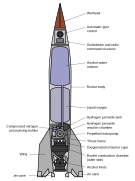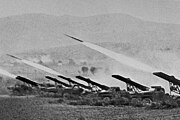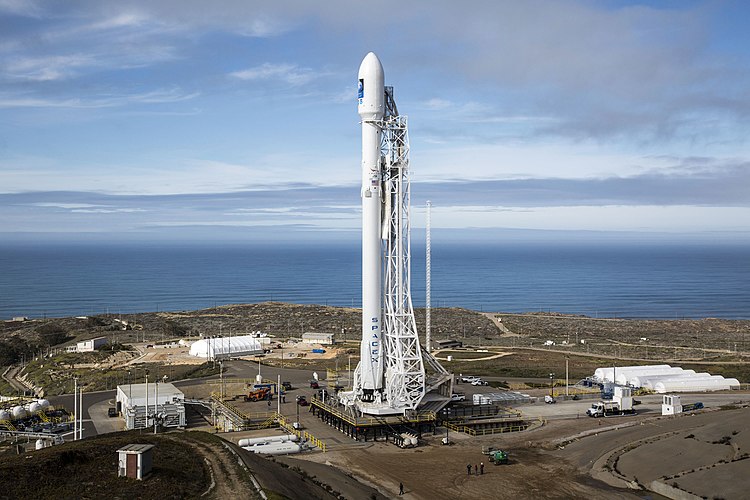Portal:Rocketry

A rocket (from Italian: rocchetto, lit. ''bobbin/spool'', and so named for its shape) is a vehicle that uses jet propulsion to accelerate without using any surrounding air. A rocket engine produces thrust by reaction to exhaust expelled at high speed. Rocket engines work entirely from propellant carried within the vehicle; therefore a rocket can fly in the vacuum of space. Rockets work more efficiently in a vacuum and incur a loss of thrust due to the opposing pressure of the atmosphere.
Multistage rockets are capable of attaining escape velocity from Earth and therefore can achieve unlimited maximum altitude. Compared with airbreathing engines, rockets are lightweight and powerful and capable of generating large accelerations. To control their flight, rockets rely on momentum, airfoils, auxiliary reaction engines, gimballed thrust, momentum wheels, deflection of the exhaust stream, propellant flow, spin, or gravity.
Rockets for military and recreational uses date back to at least 13th-century China. Significant scientific, interplanetary and industrial use did not occur until the 20th century, when rocketry was the enabling technology for the Space Age, including setting foot on the Moon. Rockets are now used for fireworks, missiles and other weaponry, ejection seats, launch vehicles for artificial satellites, human spaceflight, and space exploration.
Chemical rockets are the most common type of high power rocket, typically creating a high speed exhaust by the combustion of fuel with an oxidizer. The stored propellant can be a simple pressurized gas or a single liquid fuel that disassociates in the presence of a catalyst (monopropellant), two liquids that spontaneously react on contact (hypergolic propellants), two liquids that must be ignited to react (like kerosene (RP1) and liquid oxygen, used in most liquid-propellant rockets), a solid combination of fuel with oxidizer (solid fuel), or solid fuel with liquid or gaseous oxidizer (hybrid propellant system). Chemical rockets store a large amount of energy in an easily released form, and can be very dangerous. However, careful design, testing, construction and use minimizes risks. (Full article...)
Antares (/ænˈtɑːriːz/), known during early development as Taurus II, is an American expendable medium-lift launch vehicle developed and built by Orbital Sciences Corporation (later Orbital ATK and Northrop Grumman) with financial support from NASA under the Commercial Orbital Transportation Services (COTS) program awarded in February 2008, alongside the company's automated cargo spacecraft, Cygnus. Like other launch vehicles developed by Orbital, Antares leveraged lower-cost, off-the-shelf parts and designs.
The first stage is liquid fueled, burning RP-1 (kerosene) and liquid oxygen (LOX). Due to Orbital's limited experience with large liquid stages, the construction was subcontracted to the Ukrainian companies Pivdenne and Pivdenmash. Initially, the Antares 100 series used refurbished NK-33 engines, remnants of the Soviet N1 moon rocket. However, after a catastrophic explosion, the Antares 200 series transitioned to newly built Russian RD-191 engines. Following Russia's invasion of Ukraine, Northrop Grumman announced plans for the Antares 300, featuring a new first stage developed in partnership with Firefly Aerospace. The new first stage, similar to Firefly's MLV launch vehicle, will incorporate composite structures and seven Miranda engines, increasing Antares's payload capacity. (Full article...)
- 26 November 2024 – Japanese space program
- JAXA aborts an Epsilon S engine test after a fire occurs at the Tanegashima Space Center in Kagoshima Prefecture, Japan. (DW) (CNA)
- 21 November 2024 – Israel–Hezbollah conflict
- Hezbollah fires a rocket barrage at northern Israel, killing one person in the city of Nahariya. (Reuters)
- 19 November 2024 –
- SpaceX launches their sixth Starship rocket at the Boca Chica launch pad in Brownsville, Texas, U.S. (Reuters)
- 6 November 2024 – Israel–Hezbollah conflict
- Hezbollah fires rockets at Tel Aviv, Israel, with a rocket striking Ben Gurion Airport. (Yedioth Ahronoth)
 |
Here are some tasks awaiting attention:
|
The following Wikimedia Foundation sister projects provide more on this subject:
-
Commons
Free media repository -
Wikibooks
Free textbooks and manuals -
Wikidata
Free knowledge base -
Wikinews
Free-content news -
Wikiquote
Collection of quotations -
Wikisource
Free-content library -
Wikispecies
Directory of species -
Wikiversity
Free learning tools -
Wikivoyage
Free travel guide -
Wiktionary
Dictionary and thesaurus




















































